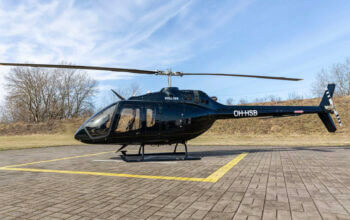Estimated reading time 5 minutes, 27 seconds.
Price may have been the determining factor in the selection of the C295W for Canada’s next fixed-wing search and rescue aircraft, but opportunities for Canadian companies in the Airbus Defence & Space supply chain were also critical to the successful bid.

The C295W edged out Leonardo’s C-27J in December for a $2.4 billion contract to provide the Royal Canadian Air Force (RCAF) with 16 aircraft to replace aging CC-115 Buffalos and CC-130H Hercules, a new operational training centre, and an initial five years of in-service support. Options for an additional 15 years of maintenance and support services could bring the total contract value to $4.7 billion.
Both bids were deemed compliant, and the final decision “came down to the cost,” Judy Foote, Minister of Public Services and Procurement Canada, told Skies in an interview at the time.
However, proposals for industrial and technological benefits (ITBs), or offsets, for Canadian defence and aerospace companies received considerable weight in the final analysis, said Navdeep Bains, Minister of Innovation, Science and Economic Development (ISED), speaking in Montreal on April 3 during International Aerospace Week.
“Airbus won the competition in large part because its value proposition [VP] included strong partnerships with Canadian industry,” he said.
Bains noted the government’s relatively new VP requirement, which is tailored in consultation with prospective bidders for each major capital defence procurement, was purposely structured to take advantage of Canada’s commercial and defence technological strengths and “ensure the aircraft would be maintained in Canada by Canadians.”
John MacInnis, deputy director of ITBs for ISED, said the framework for the acquisition contract was designed to “motivate…activities focused on the VP pillars of supplier development and research and development, and…to incentivize bidders to provide access to intellectual property for Canadian companies.”
Likewise with in-service support (ISS), bidders were required to partner with a Canadian ISS integrator to ensure “much of the sustainment activities occur in Canada.” By securing intellectual property and access rights, the government also sought to ensure “the Canadian entity could leverage what they do on the Canadian aircraft for potential international opportunities,” he said.
Both Bains and MacInnis pointed to Airbus partnerships with Pratt & Whitney Canada, CAE, Heroux-Devtek and Provincial (PAL) Aerospace as examples of what well-crafted ITBs can deliver. Airbus and Pratt & Whitney, for example, plan to develop a variant of the PW127G turboprop engine for Canadian and other C295 customers, while CAE is expected to build a “turnkey training solution” that could be exported.
And for ISS, Airbus and PAL have created AirPro, a Canadian company that could eventually provide ISS-related program management, engineering and other services to international fleets of C295 aircraft.
Both also emphasized that similar opportunities for small- and medium-sized businesses would be available under the CF-188 fighter jet replacement and interim F/A-18 Super Hornet acquisition projects.
“We believe the project can be leveraged to ensure there are strategic work packages in the global value chains of some very large multinational companies,” MacInnis said of the eventual Hornet replacement program.
In an opening address that highlighted the importance of ITBs to the government’s larger innovation agenda–especially spurring new investments in vital academic and industry R&D initiatives–Bains praised the aerospace sector for its leadership.
“We are in a global race for innovation,” he said. “You are exactly the advanced manufacturing firms we’d like to support.”
He argued that companies like CAE and Heroux-Devtek represent not just strong Canadian firms, but recognized global brands that the government would like to encourage and help other companies to attain.
“That is what our government is focused on, that level of ambition,” he said. And ITBs are “an example of how our government can use its enormous purchasing power in smart ways to support innovation as well as the start-up, scale-up and growth of new companies.”
Over the past 30 years, 137 defence procurement projects have generated $41 billion in ITB obligations, 90 per cent of which are in progress or have been completed, he said. In fact, $3.8 billion of ITBs have yet to be fulfilled, and that does not include massive opportunities under the fighter replacement and combat shipbuilding projects.
To underscore the role ITBs play, Bains confirmed a $10 million investment framework agreement on Monday between Lockheed Martin and Mannarino Systems & Software to further develop and commercialize Mannarino’s airborne software products. The investment, the largest by Lockheed Martin in a Canadian SME, is part of its ITB obligations under the 2010 CC-130J Super Hercules contract.








